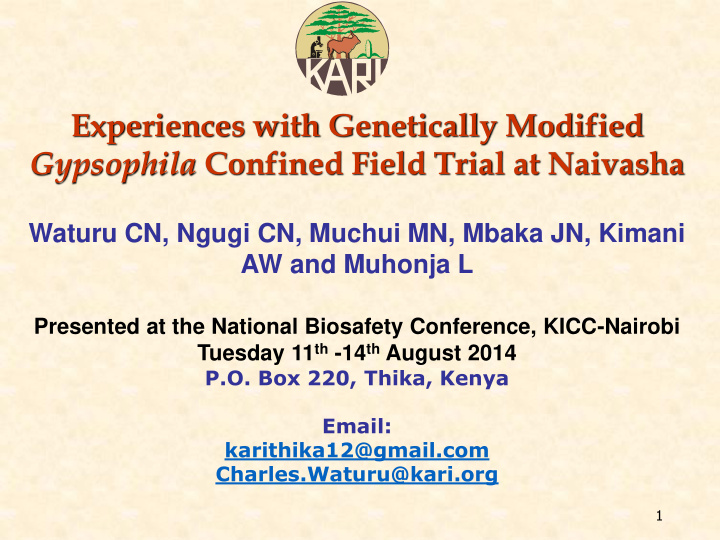



Experiences with Genetically Modified Gypsophila Confined Field Trial at Naivasha Waturu CN, Ngugi CN, Muchui MN, Mbaka JN, Kimani AW and Muhonja L Presented at the National Biosafety Conference, KICC-Nairobi Tuesday 11 th -14 th August 2014 P.O. Box 220, Thika, Kenya Email: karithika12@gmail.com Charles.Waturu@kari.org 1
Presentation Outline • Project Title • Background Information • GM Gypsophila • Research Themes • Site Preparation and Planting • Data Collection • Challenges • Acknowledgements
Project Title • Field Evaluation of Transgenic Gypsophila paniculata for Colour Stability and Environmental Impact
Background Information • Gypsophila ( Gypsophila sp .) originated in Eurasia, now commercially grown as a cut flower. • It belongs to the Caryophyllaceae family • Common commercial variety is Gypsophila paniculata • Has predominantly white flowers and in rare cases light pink flowers. • Used as filler for floral arrangements and bouquets
Background Information • Danziger (Israel) has developed new varieties ranging from dark purple and red to light pink through introduction of Pap1 gene. • NBA requires introduction of GM crops be preceded by generation of biosafety data • The objective is to evaluate transgenic Gypsophila paniculata varieties for biosafety and pink colour stability.
GM Gypsophila
Species Name and Habitat Species name: Gypsophila paniculata L. Common Name: Baby's breath Herbaceous perennial plant grown as an annual crop in hotter climates
Modified Trait Conventionally, ornamental Gypsophila is available in predominately one colour- white Very limited varieties and limited climate conditions also light pink Introduced gene Pap1 (Production of Anthocyanin Pigment 1) is a Myb transcription factor Known to regulate the production of phenylpropanoid, including anthocyanin pigments
Gene Donor and Vector Gypsophila varieties are genetically engineered for constitutive expression of the Pap1 gene isolated from Arabidopsis thaliana Binary transformation vector pCGN1599 Binary plasmid doesn't contain oncogenic genes which lead to the pathogenesis of the natural agrobacterium
Research Themes
Scientists and Research Themes Research Expertise Research Theme(s) Scientist 1 Dr CN Entomologist/ Effect of Crude extract of GM Waturu/Cecilia Gypsophila on infectivity and Biotechnologist Ngugi development of Entomopathogenic Nematodes Below ground effect of transgenic Gypsophila on EPNs Effect of transgenic Gypsophila on aerial and ground arthropods diversity 11
Scientists and Research Themes Research Expertise Research Theme(s) Scientist 2 Dr J. Mbaka Plant Effect of transgenic Gypsophila on Pathologist rhizosphere bacterial/fungal and nematode communities populations 3 Dr D. Gikaara/ Soil Scientist/ • Evaluation of colour stability and Dr M. Floriculturist/ yield/quality performance Muchui/Ms. Post-harvest Linah Muhonja Physiologist 12
Scientists and Research Themes Research Expertise Research Theme(s) Scientist 5 Ms. C Taracha Molecular Field assessments of pollen-mediated gene flow (PGF) from transgenic to Biologist non transgenic Gypsophila 6 MS S. Wambua Economist Economic evaluation of the transgenic and non transgenic Gypsophila 7 MS A Kimani ICT Role of ICTs for Effective Dissemination of Transgenic Gypsophila Technology and Knowledge 13
Site Preparation and Planting
Trial Site
Distribution of Gypsophila in Naivasha
GM Gypsophila CFT Site
Site Preparation
Seedlings Transportation
GM Gypsophila Seedlings
GM Gypsophila Planting
Data Collection
Pests and Natural Enemies
Beneficial Arthropods Transgenic Conventional
Pot EPN Studies
Effect of Plant Extract/ EPN Studies
Gene Flow Studies
Postharvest Studies
Soil Microbial Studies
Challenges
Cutworm Damage Weed infestation Diseased plants
Acknowledgements • Director KARI • CEO Danziger Ltd • Manager Beauty Line Farm Naivasha • CEO NBA • All Support Staff • Biosafety Conference Organizers • Audience
Tha Thank nk You You KARI-Thika
Recommend
More recommend